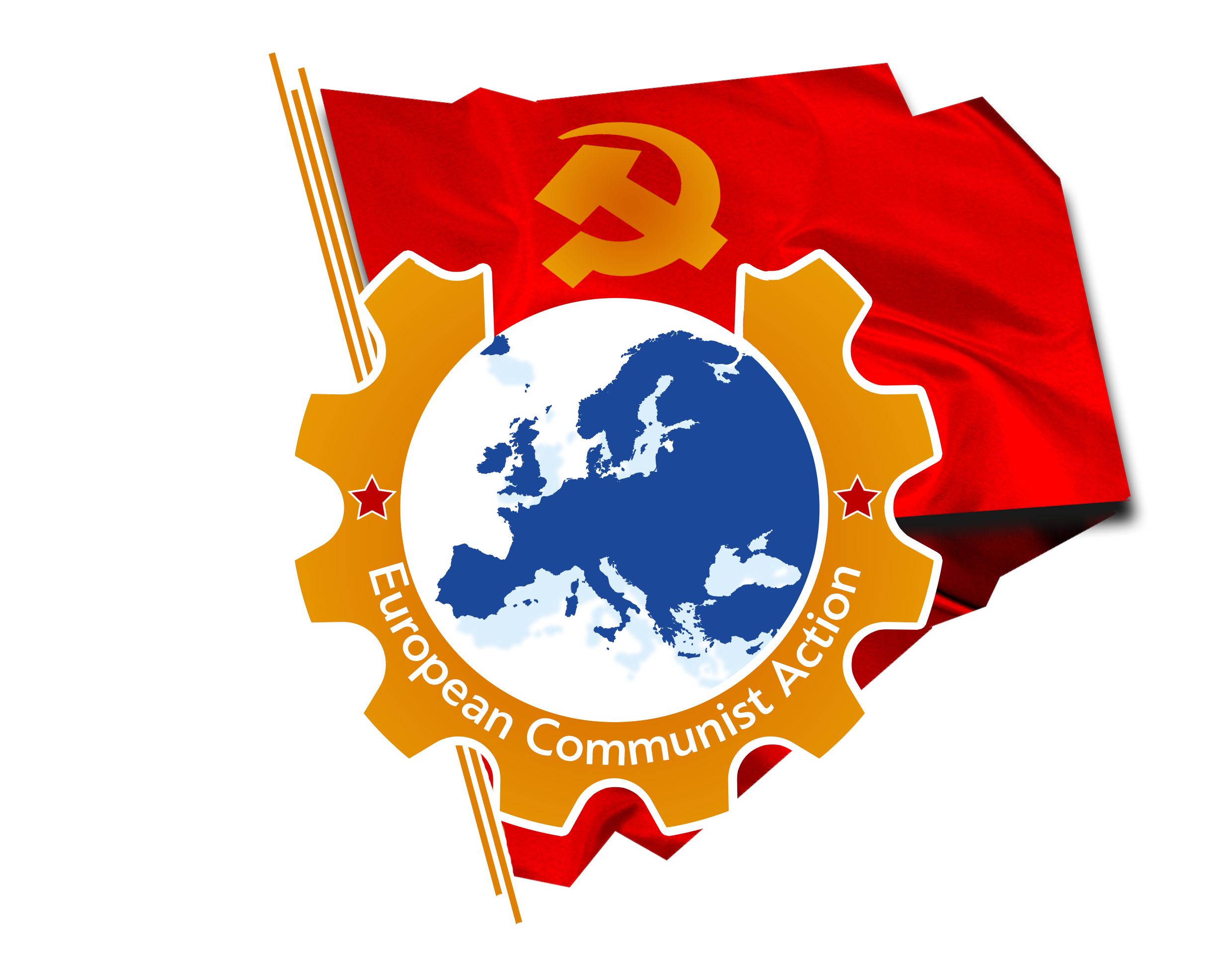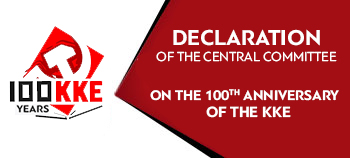Links to the old web pages of KKE
On the war in Ukraine and China’s “proposals for peace”
Their peace is being built upon the ashes and in the fire of the imperialist war

“Those at the top say:
Peace and war
Are of different substance.
But their peace and their war
Are like wind and storm.
War grows from their peace
Like son from his mother.
He bears
Her frightful features.”
B. Brecht, From A German War Primer
“Peace processes” and related initiatives —in essence settlements through the intervention of powerful imperialist powers— have been taking place in many parts of the world since the very first days of spring.
A French-German “peace plan” is being promoted in Serbia, calling the Serbian government to accept the implicit recognition of the NATO protectorate of Kosovo in exchange for “facilitating” the accession of Serbia and Kosovo to the ranks of Euro-Atlanticism.
A five-party “security conference” between the USA, Israel, Egypt, Jordan and the Palestinian Authority was held in Aqaba, Jordan, with the aim of “de-escalating and preventing further violence” between the perpetrator (Israel) and the victim (the people of Palestine).
In India, first the finance ministers and then the foreign ministers of the G20, i.e. the 20 most powerful capitalist states, discussed global security issues; however, they failed to reach an agreement.
In addition, China put forward its own “12-point plan” for resolving the war in Ukraine, which in the body of the text is not called by its name but is referred to as the “Ukrainian crisis”.
To paraphrase the poet Brecht, we must say that in all the above “peace plans”, “peace” resembles imperialist war and bears its repulsive characteristics. For example, the profits of the monopolies, i.e. the causes that have led to imperialist interventions and wars, continue being the cornerstone of all the above plans.
In this article, we will deal exclusively with the Chinese “peace plan” 1 in regard to the imperialist war in Ukraine.
A strange kind of war...
The truth is that the Russian invasion of Ukraine in February 2022 was only the formal declaration of a war that had been going on for years between the US-NATO-EU powers, which are using Ukraine as their spearhead, and capitalist Russia, which is being utilized as China’s cushion in the latter's acute conflict with the USA over supremacy in the imperialist system.
For sure, we are talking about a strange kind of war. At the same time when thousands of people are being slaughtered in the battles, the capitalists on both sides of the war and their governments still maintain —albeit limited compared to before February 2022— a solid partnership, including trade cooperation.
Thus, for example, Russia continues selling the USA and France uranium for their nuclear facilities. In fact, it covers 20% of the needs of the 92 US nuclear reactors 2, while in 2022 France received 153 tonnes of Russian uranium, covering 15% of its needs 3. Another example: On 2 March, a spacecraft with a four-member crew (including two Americans, one United Arab Emirates astronaut and one Russian cosmonaut), was launched from NASA’s Kennedy Space Center in Cape Canaveral, Florida, heading for the International Space Station. On the same day, the Russian “Gazprom” announced that it had sent 42.4 million cubic metres of natural gas to the EU through the pipelines of war-torn Ukraine, to the delight of its capitalist shareholders. Moreover, the US “Chevron” continues to load the oil it extracts from Kazakhstan at the Russian port of Novorossiysk on the Black Sea, which arrives there via a 1,500-kilometre pipeline passing through the territory of Kazakhstan and Russia. It is through this pipeline that two-thirds of the oil extracted in Kazakhstan are put on the world market.
Moreover, Russian raw materials and other commodities continue to be channelled through “third parties” to the so-called “collective West” —in the words used by Russia to describe the countries enforcing the trade embargo against it— even including Japan or Australia, which are not geographically part of the West.
And, on the other hand, products made in the “Collective West” are sold to Russia through the so-called “Global South”, which is now the name given to countries that do not enforce the anti-Russia embargo, including China, India, Turkey and other countries that are not, of course, in the southern hemisphere of the Earth.
Moreover, new trade corridors are opened up, such as the International North–South Transport Corridor (INSTC), e.g. from Russia to the ports of Iran via the Caspian Sea.
There is something really odd about this “new geography” and similarly about this imperialist war, which, while claiming thousands of lives, mainly of young people in Ukraine and Russia, at the same time continues to proliferate the profits of the few on both sides of the war, who are getting richer...
... and the corresponding Minsk “peace agreements”
The recent Chinese “peace plan” is not the first one concerning this war. It was preceded by the so-called Minsk agreements.
Once again, Brecht’s words are perfectly valid for these agreements:
“When the leaders speak of peace
The common folk know
That war is coming.
When the leaders curse war
The mobilization order is already written out.”
It is characteristic that the KKE, from the very first moment, stressed the so-called “diplomatic ambiguity” of the specific Minsk agreements, which suggested that they were only a ceasefire agreement until bloodshed began again.
It is known today from the admissions of Zelenskiy and Merkel that the EU-NATO side did not intend to implement any of those. Furthermore, from a statement by V. Surkov, a former adviser to the Russian President and one of the authors of the Minsk Agreement 2, it is clear that neither the Russian side believed in the implementation of those agreements when it was preparing and signing them 4.
Then why were they prepared and signed, giving false hope to millions of people, first and foremost those in the war zone?
Let us recall that the Minsk Agreements 1 and 2 were signed in 2014 and 2015 respectively, under the auspices of the Organization for Security and Cooperation in Europe (OSCE). Such was their ambiguity about how the notorious independence of the Donbas regions would be implemented while simultaneously preserving the territorial integrity of Ukraine, that the question arose: Why were they signed in the first place? Why had both sides been beating about the bush for 8 years while the carnage continued?
The answer is because they served all sections of the bourgeoisie and expressed a temporary compromise considering the existing correlation of forces!
They served the Ukrainian bourgeoisie, which in the meantime amended the constitution by adopting the orientation towards EU and NATO membership and took new anti-communist and overall anti-democratic measures against those who questioned its geopolitical choices. It also resupplied the army with US and generally Western weapons, rebuilt it and co-opted Azov Battalion-type fascist armed groups into it. Therefore, it needed to win time.
They served the Russian bourgeoisie and the corresponding section of capitalists that had the upper hand in the so-called “People’s Republics” of Donbas, because they mopped up any element within the armed self-defence groups of Donbas that was not under their control. During this time, as if by magic, all the commanders of the armed self-defence groups in Donbas who declared themselves communists and leftists were exterminated. The Russian bourgeoisie took a whole series of measures to control the situation in Donbas, through financing and reorganizing the bourgeois administrative apparatus of the so-called “People’s Republics”, undertaking the equipping of their forces and even promoting extreme right-wing, nationalist armed paramilitary organizations, following the example of the Ukrainian bourgeoisie.
When the various forces involved in the conflict considered that the objectives they had set were achieved and that the balance of power was now in their favour, the Minsk agreements were formally terminated.
That is pretty much how things stand with the Minsk agreements.
The new Chinese plan...
China’s peace plan consists of 12 points, which are more similar to a formulation of “rules” that will allegedly lead to peace, as their initiators claim.
In summary, it is as follows:
Point Ι: Respecting the sovereignty of all countries. Universally recognized international law, including the purposes and principles of the United Nations Charter, must be strictly observed. The sovereignty, independence and territorial integrity of all countries must be effectively upheld. (…)
Point ΙΙ: Abandoning the Cold War mentality. The security of a country should not be pursued at the expense of others. The security of a region should not be achieved by strengthening or expanding military blocs. The legitimate security interests and concerns of all countries must be taken seriously and addressed properly. (...)
Point ΙΙΙ: Ceasing hostilities (...)
Point ΙV: Resuming peace talks (...)
Point V: Resolving the humanitarian crisis (...)
Point VI: Protecting civilians and prisoners of war (POWs) (...)
Point VII: Keeping nuclear power plants safe (...)
Point VIII: Nuclear weapons must not be used and nuclear wars must not be fought (...)
Point IX: Facilitating grain exports (...)
Point X: Stopping unilateral sanctions (...)
Point XI: Keeping industrial and supply chains stable (...)
Point XII: Promoting post-conflict reconstruction. The international community needs to take measures to support post-conflict reconstruction in conflict zones. China stands ready to provide assistance and play a constructive role in this endeavor.
...and its “diplomatic ambiguity”
The first impression that this proposal may give the unsuspecting reader is that it is indeed a good and coherent proposal to finally reach a peaceful solution. There were CPs from other countries who welcomed it, such as the Eurocommunist CP of Spain, which is full of praise for peace, while participating in a government of a NATO member country that is actively involved in the war, sending large quantities of weapons to the reactionary Zelenskiy government. Such is their hypocrisy!
On a second reading, however, any reader of this sentence will understand that we are dealing with yet another “diplomatic ambiguity”.
Thus, the Chinese plan speaks in general terms of “respecting the sovereignty of all countries”, of “the independence and territorial integrity of all countries”. It is noteworthy that the Ukrainian President V. Zelenskiy found these passages of the Chinese proposal positive, assuming that China is referring to the sovereignty and territorial integrity of Ukraine that were abolished by the Russian military invasion in 2022. However, the Russian side also has no objection to these phrases of China’s proposal, as it considers both Crimea, which was annexed to Russia in 2014, and the new regions annexed to the Russian Federation in 2022 to be part of Russia’s sovereignty and territorial integrity. Crimea, Donetsk, Luhansk, Kherson, Zaporizhzhia are considered Russian regions, which are now mentioned by name in Chapter 3, Article 65 of the revised Constitution of the Russian Federation 5.
Therefore we can all understand that China’s proposal, which generally refers to the “territorial integrity” of all countries, contains a lot of “diplomatic ambiguity” and clearly has a double reading, at the same time that China is calling for an end to the use of “double standards” in international relations.
Moreover, all the references about the “security of a country” that “should not be pursued at the expense of others” are already included in the documents of the OSCE, which, in addition to the EU countries, comprises Russia and the USA. Yet all these proclaimed principles and so many other pro-peace declarations that all the bourgeois states have signed up to were unable to prevent the war. Why would the recognition of these same, oft-repeated principles stop it now?
To understand what exactly is going on with this Chinese plan, we need to look at the overall picture, which has two main aspects:
a) The escalation of the conflict and the reinforcement and upgrading of the weapons systems that both sides are using in the military conflict.
b) The so-called reconstruction of Ukraine, including the “new regions”, as Russia describes the territories it has annexed.
The military aspect of China’s involvement in the war
According to Xiang Lanxin, a Chinese professor of World History and Politics, “the Chinese military had overestimated the capabilities of the Russian army. In fact, they should know their Russian counterparts better than anyone else —we have taken part in many joint exercises, we have interacted and held dialogues at many different levels. We have come to believe that, despite its economic problems, Russia remains the world’s second power in the military field. But to be honest, China expected much more from Russian military capabilities. And this is a lesson being taken very seriously into account” 6.
The specific difficulties of the Russian army are clearly being studied by the NATO side as well, particularly in view of the military objectives set by each side. If the Ukrainian side, which is obtaining new weapons from NATO, sets as its military objective the “liberation” of all Ukrainian territories, including Crimea, the Russian side sets as its primary military objective the “liberation” of all the administrative boundaries of the regions it has annexed. Moreover, we cannot overlook the fact that Odesa is the only major city, located in the centre of a strip of territory less than 150 km long, which Russia could seek to occupy in order to complete the total separation of Ukraine from the Black Sea, thus allowing the formation of a land channel with the important “enclave” of Transnistria, the region that has been detached from Moldova and whose leadership has been seeking to be a part of Russia for years.
New weapons are being launched in the battlefields. Their effectiveness is a litmus test not only for their sale in the big arms market, where the USA, Russia, France, China and Germany have a clear lead, but also for the territorial “gains” of each side in the imperialist conflict.
In recent days, the US has been spreading rumours that China is preparing to send new weapons to Russia. In fact, the US has imposed sanctions on the Chinese “Spacety” company, which it accuses of providing aerial photographs to the Russian “Wagner” private army that has emerged as the “spearhead” of Russian military operations on Ukrainian territory. The head of the “Wagner Group”, trying to refute those accusations, claimed that for the past year and a half the private Russian army has had about 20 satellites at its disposal and, thus, it can see any place on Earth and does not need aerial photographs from Chinese satellites 7. At the same time, the confrontation between Wagner and the Russian Ministry of Defence regarding its ammunition supply became known, which, apart from various intrigues within the Russian leadership, confirms the importance of further uninterrupted supply of Russian operations with ammunition and new weapons, to which China can indeed contribute.
China’s proposal for “peace” is therefore intended to maintain China’s status of “formal neutrality” in the conflict. At the same time, in the event that China’s proposal is met with rejection, as in the case of the USA, China will be provided with an additional pretext for selling arms and ammunition to Russia. No one can underestimate that China is currently the 4th largest arms dealer in the world and that it can directly supply Russia with both ammunition and modern weapons.
The “feast” of reconstruction is already being prepared before the war is over
China’s proposal comes at a time when there are no significant changes on the battlefields. While the war rages on and blood is being spilled on both sides, the “feast” of reconstruction of destroyed infrastructures and cities has already started.
Werner Hoyer, President of the European Investment Bank (EIB), said that this bank in 2022 alone “financed projects worth €2.2 billion in Ukraine, mainly in transport infrastructure, energy, water supply, power transmission, schools, hospitals, with its current exposure amounting to €7.3 billion”. He noted that the bill for the “reconstruction” of Ukraine will be huge and that “guarantees” will be needed, and called for “support by the EU and mobilization of the private sector before the war is over” 8.
Similarly, in the regions occupied by Russia, which are by no means negligible since 11 million people live on them (2.2 in Luhansk, 4 in Donetsk, 1.5 in Zaporizhzhya, 1 in Kherson, 2.5 in Crimea), there are an abundance of industrial plants, mineral wealth and fertile lands. While the war continues, 50,000–60,000 construction workers are already working 24 hours a day in 3 shifts for the reconstruction of these regions (except for Crimea, which has been annexed to Russia since 2014). According to the data of the new sub-directorate of the Russian Ministry of Infrastructure, 4,700 buildings and infrastructure had been restored as of 1 March 2023 in the “new regions” —as they are called— of Russia 9.
China’s proposal, which emphasizes “post-conflict reconstruction”, is in fact its expression of interest in the race of all those construction monopolies and “reconstruction banks” that expect to gain a share of the “reconstruction” pie of the war-damaged infrastructure and houses, which once again will be paid for by the people.
The Chinese dragon with its economic and political resources is claiming what it believes to be its rightful place, including at the heart of Europe.
1. Ministry of Foreign Affairs of China, https://www.fmprc.gov.cn/mfa_eng/zxxx_662805/202302/t20230224_11030713.html
2. "Russia's nuclear fuel and technology exports grew by more than 20 percent in 2022", https://forbes.ua/ru
3. "France bought 153 tons of enriched uranium from Russia for its nuclear power plants in 2022", https://tass.ru
4. Russian news agency "TASS", 16/2/23, https://tass.ru
5. The Constitution of the Russian Federation with the 2022 changes, State Duma website - http://duma.gov.ru
6) Interview of Xiang Lanxin with F. Lukyanov, editor-in-chief of the magazine "Russia in Global Affairs", https://globalaffairs.ru
7) "Donbas News", https://novosti.dn.ua/ru
8) Werner Hoyer: "The reconstruction bill in Ukraine will be huge", https://www.in.gr
9) "How Russia is resurrecting Neo-Russia from the ruins", https://baltnews.com






